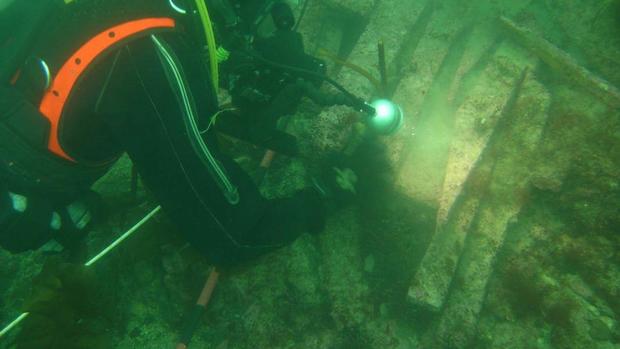Doggerland, northern Europe's own lost city of Atlantis, discovered off Scotland
(CBS News) LONDON - British scientists scouring the bottom of the North Sea have begun piecing together a picture of life in Doggerland, what they believe was the "heart of Europe," connecting modern day Britain to continental Europe, until about 7,000 years ago.
Among fossilized evidence of mammoths and large game animals, divers have found harpoons, flint tools and suspected burial sites they say belonged to residents of the submerged settlement more than 12,000 years ago.
A team organized by Dr. Richard Bates, a geophysicist at the University of St. Andrews, says the evidence points to a once-dry land passage between Scotland and Denmark which that was likely larger than many modern European cities, with tens of thousands of ancient humans calling it home.
"We haven't found an 'x marks the spot' or 'Joe created this', but we have found many artifacts and submerged features that are very difficult to explain by natural causes, such as mounds surrounded by ditches and fossilized tree stumps on the seafloor," explains Bates.
"There is actually very little evidence left because much of it has eroded underwater; it's like trying to find just part of a needle within a haystack," he adds. "What we have found though is a remarkable amount of evidence and we are now able to pinpoint the best places to find preserved signs of life."
Bates says Doggerland was inhabited by a large number of hunters and gatherers, who roamed the ancient expanse of land stretching all around the British Isles and connecting what is now England to France and the Lowlands, and what is now Scotland to Denmark in the north.
The passage is believed to have been above land from about 18,000 BC until 5,500 BC, when rising sea levels and a devastating tsunami submerged the remaining islands.
Perhaps the most astounding aspect of the Doggerland discoveries is the insight it may provide into human life more than 12,000 years ago, particularly in difficult climates.
Bates says the findings suggest early man was able to survive, and thrive, "up through the north, more than we ever thought that they should."
Using a combination of geophysical modeling data from oil and gas companies, and direct evidence from materials recovered from the seafloor, the research team has been able to build a model of what the lost land likely looked like to its inhabitants.
"We have now been able to model its flora and fauna, build up a picture of the ancient people that lived there and begin to understand some of the dramatic events that subsequently changed the land, including the sea rising and a devastating tsunami," explains Bates.
The research team isn't finished yet. They're currently investigating further evidence of human presence and behavior in Doggerland, including possible human burial sites, intriguing standing stones and a mass mammoth grave.
The research project is a collaboration between St. Andrews and the Universities of Aberdeen, Birmingham, Dundee and Wales Trinity St. David. The artifacts go on display this week at The Royal Society's Summer Science Exhibition in London.
This story was filed by CBS News' Leigh Kiniry in London.